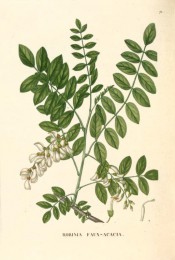Robinia pseudo-acacia L.
Fully-hardy, fast-growing, broadly columnar tree with spiny shoots, pinnate leaves, composed of up to 23 lance-shaped leaflets, and pendant racemes, to 20cm long, of fragrant white flowers, to 2cm long, in summer, followed by smooth brown seedpods. To 25m. [RHSE, Hortus, Hilliers’].
Horticultural & Botanical History
‘Robinia pseudo-acacia, or Yellow Locust Tree. This is superior to any other kind of wood for ship-trunnels, mill-cogs, and fence-posts, as well as for various other purposes. Its culture is very easy, and it may be propagated in great abundance, by sowing the seed in March, April, or May, in a bed of good sandy loam, which is its favourite soil, and covering them half an inch deep. Previous to sowing, put the seed in a basin, pour on scalding water, and let it stand all night; pick out such seed as are swollen, and plant them immediately; next evening repeat the same process with such as did not swell the first night, mix the whole and sow them; they will come up in the course of the following month numerously; for no seed grow more freely, notwithstanding what some say to the contrary. When the plants are a year old, transplant them out of the seed-bed into nursery rows, four feet distant, and plant from plant one foot. Having had two or three years’ growth in these rows, they may be planted successfully in any warm and tolerably rich sandy soil. They may also be propagated by suckers, which they throw up abundantly, especially if some of the wide extending roots be cut through with an axe.’ [Bridgeman – The Florist’s Guide p.43/c.1849].
Figured by Saint-Hilaire. [Saint-Hilaire Arb. pl.71/1824]. Introduced to Europe before 1601. [Beadle].
History at Camden Park
Listed in all published catalogues [T.833/1843].
Notes
It was introduced to France in 1601 and is now widely naturalised there, as well as elsewhere in Europe. It is also naturalised locally in Eastern Australia, usually close to where it was originally planted, and is considered a significant weed in places. [Beadle].
Published Dec 24, 2009 - 05:23 PM | Last updated Jul 21, 2010 - 12:46 PM
| Family | Fabaceae |
|---|---|
| Category | |
| Region of origin | Eastern USA |
| Synonyms | |
| Common Name | Locust tree, Black locust, False acacia, Bastard acacia |
| Name in the Camden Park Record |
Robinia pseud-acacia - Common acacia, or American locust tree |
| Confidence level | high |


